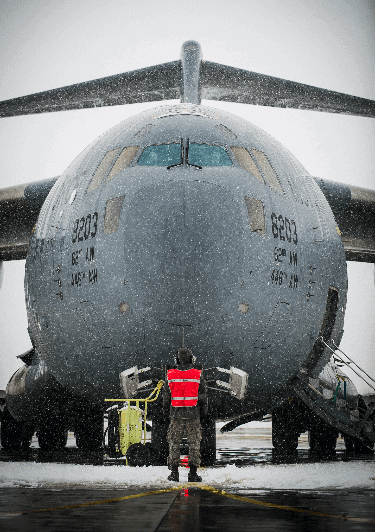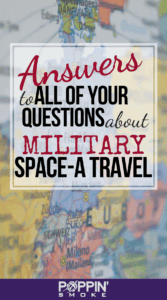Find the answers to your Space-A travel questions here!
>> Get the full scoop on using Space-A flights and lodging with our free 45-page Guide to Military Space-A Travel.

Contents (click to expand)
1. How does Space-A flying work?
Read this Quickstart Guide to Space-A Flights to get a detailed overview of the entire Space-A flying process.
2. How much do Space-A flights cost?
There is no charge to fly Space-A except for on Patriot Express (PE) flights. Space-A passengers pay a small per-person tax on the PE.
Some terminals offer box lunches for purchase. They usually cost $5 – $10 and are distributed onboard the aircraft.
3. Who is eligible to fly Space-A?
Visit the Air Mobility Command website for a list of eligible travelers.
To learn more about how priority for Space-A passengers is determined and which passengers have restrictions on where they can fly, read this section of our Quickstart Guide to Space-A Flights.
4. Is Space-A travel open for retirees?
Yes. Space-A reopened for all categories of travelers in April 2022.
Click here for Space-A signup tips for retirees.
5. Can 100% disabled veterans fly Space-A?
Yes. Veterans who are not retired from the military and have a permanent service-connected disability rated as total (and their accompanying dependents) can fly Space-A within the contiguous United States (CONUS) and to/from Hawaii Alaska, Guam, and other U.S. territories. They cannot fly Space-A to, from, or within foreign countries.
6. Can retired military dependents fly Space-A?
Yes, but only when accompanied by their sponsor.
7. Can widows fly Space-A?
Yes, surviving spouses of deceased service members/retirees can fly Space-A, but only within the contiguous United States. They are in Category 6.
Learn more about travel-related benefits for surviving spouses in this article.
8. Can civilians fly Space-A?
Certain DoD civilians and their dependents stationed overseas are eligible to fly Space-A. Consult DoD Instruction 4515.13 Air Transportation Eligibility for details.
9. How do I sign up to fly Space-A?
You can sign up via e-mail, fax, using the Take-a-Hop app, or through the Air Mobility Command website’s online form. You can also sign up in person at the terminal.
Active duty can sign up as soon as they are on leave.
Retirees and 100% disabled veterans (Category 6) can sign up a maximum of 60 days prior to the date of travel. Click here for detailed information about Category 6 signup.
Signup rules for unaccompanied dependents vary by situation and are explained here.
10. What should I bring on a Space-A flight?
This Space-A Packing List explains what to wear and what to bring on a Space-A flight, including required documentation.
11. Where can I find Space-A flight schedules?
Most military passenger terminals post their Space-A flight schedules on their respective pages on the Air Mobility Command website. You can also obtain flight schedules by calling the terminal directly.
Scroll down to the Passenger Terminal Directory on the Air Mobility Command Travel Page to see a list of all terminals and their contact information, including links to their web pages.
Click here to get step-by-step instructions for finding flight schedules and a detailed guide that explains how to read them.
12. What bases have flights to [insert destination]?
This article explains how to figure out which bases have flights to the places you want to go.
13. How do I fly Space-A on the Patriot Express?
The process for flying Space-A on the Patriot Express (PE) is the same as for any other Space-A flight. The main difference is that PE schedules are available for one month at a time, whereas schedules for other Space-A flights are available up to 72 hours in advance.
Click here for more information about flying Space-A on the PE, including a list of all PE routes worldwide.
14. As a spouse, can I fly Space-A without my sponsor?
Spouses of active duty service members who are deployed 30+ days or stationed outside of the contiguous U.S. (OCONUS) are eligible to fly Space-A.
Click here to learn where you can fly, what paperwork you need, and how to sign up.
15. Do you have any advice for flying Space-A with children?
Yes! Here are 12 Tips for Flying Space-A With Kids.
16. Can I bring my pet on a Space-A flight?
No. Space-A passengers cannot bring pets or emotional support animals. They can fly with legitimate service dogs.
This interview with a retiree who has flown Space-A with his service dog multiple times explains how it works.
17. Can I fly Space-A between Europe and Asia?
Yes, but generally, you must travel via the United States. Missions usually do not fly directly between the Pacific and European theaters of operation.
We flew Space-A from Japan to Germany in March 2019. Here are our lessons learned.
18. Is flying Space-A worth it?
Yes, if you know when (and when not) to use it. It’s most challenging to get a seat on a Space-A flight during the summer PCS season (generally mid-May to mid-September) and any other time that schools are on vacation, particularly the winter holidays.
You can improve your chances of having a successful Space-A journey by following our tried-and-true tips and strategies.
19. How does Space-A lodging work?
Find everything you need to know in Space-A Lodging: Eligibility & Reservation Tips.
20. How do Space-A travelers arrange lodging without knowing when they will arrive?
We usually wait until we land to book lodging, and we always find a last-minute room. You can also make a reservation in advance once you are manifested on a flight, but don’t forget to guarantee it for late arrival and cancel it if the flight doesn’t work out.
You should never make any non-refundable reservations based on your expected arrival on a Space-A flight.
Click here for more information about how to arrange lodging when flying Space-A to Europe.
21. What facilities can I use on bases overseas?
It depends on the country. Base access is subject to the Status of Forces Agreement (SOFA) between the United States and the host country.
On most U.S. military bases overseas, retirees and active duty who are not stationed in the host country can stay in base lodging and use Morale, Welfare, and Recreation (MWR) facilities, such as the fitness center, golf course, and Outdoor Recreation. On bases in Japan and Korea, they also have commissary and Exchange privileges, but in some European countries, privileges are restricted.
The AAFES website has more detail about who can use the Exchange in each country. Commissary privileges general follow suit.

